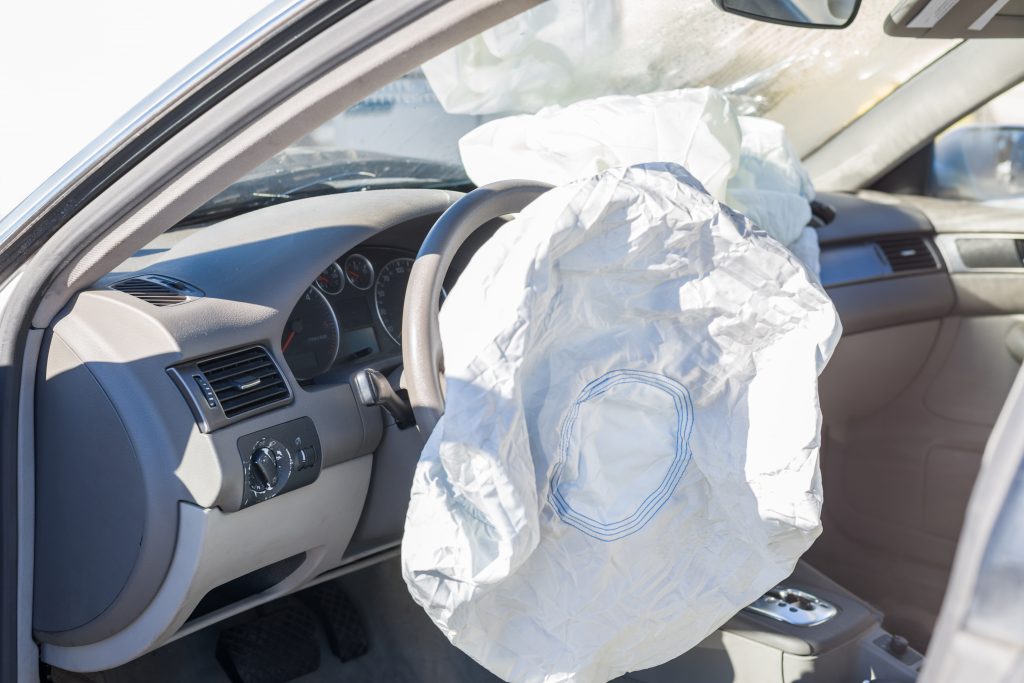The purpose of an airbag is to deploy when a severe crash has been detected. Although the airbag is a great invention that has saved many lives, these products can result in illness or injury should they malfunction. It’s important to know your legal rights in the event an airbag deploys improperly or not at all in a motor vehicle accident.
Common Airbag System Defects
The airbag system consists of several interconnected components: the indicator lamp, steering wheel connecting coil, diagnostic monitoring unit, crash sensors, and the airbag module itself.
Inside the airbag module is the airbag and a generator, which inflates the airbag with gas— typically, nitrogen. Malfunctions can occur in any of these components and, ultimately, cause the malfunction of the airbag.
A defect in the crash sensor may cause the airbag to deploy when it isn’t needed. Another common defect is when the sensor deploys the airbag slower than normal, or when not all airbags in a vehicle deploy when they’re supposed to, which can be the result of electrical failure.
Additionally, an airbag can fail to deploy altogether, which can be due to the module inside the airbag failing to release gas in response to the crash sensor. All these airbag system malfunctions can result in serious injuries requiring medical treatment.
Injuries that Airbags Can Cause
Airbags can cause a host of serious injuries and can even result in death. Because the speed of deployment is so high—typically between 100 and 220 miles per hour—a driver and passenger can sustain an injury just from being struck by it as it inflates.
When they deploy too slowly in an accident, airbags can increase the severity of injuries. For example, if a person’s head is being forced forward as the result of the impact, and the airbag deploys into their head, serious brain and neck injury could be the result.
The gas and chemicals contained in the airbag itself can be released inside the vehicle, causing burns to the skin and eye injuries. These chemicals can also cause injuries to the lungs and respiratory system. In those with asthma, an attack can be the result of inhaling the chemicals released following deployment.
Other injuries that can occur include internal organ damage, brain bleeding, and rib and skull fractures.
Be Wary of Recalls, Counterfeit, and Salvage Airbags
Takata, an airbag manufacturer, has recalled 50 million airbags since 2017, according to the National Highway Traffic Safety Administration. More recalls are planned for 2019, which will bring the number of recalled airbags to between 65 and 70 million.1
In order to check if your vehicle contains Takata airbags, consult the list of affected cars and trucks on the NHTSA website. If your vehicle is on that list, it should be taken immediately for repair.
Unfortunately, the use of counterfeit airbags is a reality. These airbags can be installed in a used vehicle, one where the airbags previously deployed and need to be replaced, or they can be purchased by a vehicle owner online for installation by a garage. These counterfeits look just like real airbags and can be obtained and installed by a garage to save on the cost of the airbag and accompanying system.
Red Flags for Counterfeit Airbags
The problem with these counterfeits is that they often won’t deploy at all, causing obvious risk to vehicle passengers. The NHTSA has outlined some scenarios which place drivers at risk of having counterfeit airbags in their vehicles.
Drivers owning a vehicle with a title that says “reconstructed,” “rebuilt,” or “salvage” are at high risk of having counterfeit airbags. Anyone who has purchased a used vehicle without being familiar with the history of that vehicle can also be at a high-risk airbag failure and car accident injuries.
Salvage Airbags
These products are typically extracted from vehicles that are completely unusable. While this may seem like an economical way to replace the airbags in another vehicle, many things can go wrong that could render them ineffective. For example, even the way in which the airbag is removed from the vehicle can cause damage that prevents it from deploying properly.
In addition to simply being removed from a vehicle, many salvaged airbags go through a reconditioning process, which can also cause damage. Finally, the complete airbag system can be compromised when a salvaged airbag is placed into a different model than it was removed from. This is because different vehicle models have made different technical improvements.
Proving Liability
If you were in an accident and believe you became injured because your vehicle’s airbags didn’t properly deploy, you can sue the company that made your vehicle, the airbag manufacturer, or the company that made the airbag sensor for damages in a product liability claim.
In addition to proving that the airbag or its components were unreasonably dangerous, a link will need to be made between your injuries and the sensor, the airbag itself, or the airbag system. Therefore, providing evidence of malfunction will be important. It’s a good idea to have the airbag, sensor, and system removed from your vehicle.
Additionally, if your vehicle was declared completely unusable by your insurance company, they will attempt to take it. However, it’s important to try to keep your vehicle, as its computer holds information that can be instrumental in establishing a product liability or manufacturing defect claim. Your vehicle may also be equipped with what’s called a “black box,” which contains data about the accident.
A product liability claim is the result of many injuries sustained because of an airbag. In this type of claim, a car wreck attorney will show that a defect in the design or manufacture of the airbag is what caused it to fail.
Design defects identify issues with how a sensor or airbag was designed by the manufacturer. In the case of a manufacturing defect, the sensor or airbag must be proven to have been made in a way that differs from the product’s intended design.
What You Should Expect from the Court Process
In addition to providing physical evidence of an airbag, sensor, or system malfunction, it may also be necessary to contact individuals who can serve as expert witnesses. They will be capable of providing technical evidence that supports your claim. Expert witnesses can include doctors, surgeons, those involved with the reconstruction of the accident, and product designers.
In court, you can expect to see auto parts and vehicle manufacturers, as well as those who may have replaced, repaired, or maintained the airbag and system components.
Why Hire an Attorney?
Airbag failure cases require a lot of legal proof. Gathering this proof can be nearly impossible if you’re trying to do everything on your own. However, when you have an attorney, gathering the right kind of evidence becomes a much easier process.
A car accident lawyer knows how to work with expert witnesses and obtain proof that your airbags didn’t deploy when they should have. If a specific reason for failure isn’t needed, an attorney can obtain testimony from the engineer, who can use data about your speed at the time of the accident to show airbag failure.
Another important reason to hire an attorney is that they can ensure you have the best chance at getting a fair settlement that covers all your expenses, including medical bills, pain and suffering, lost wages, and ongoing medical care. With an experienced attorney, there will be no place for vehicle or airbag manufacturers to hide.
Schechter, McElwee, Shaffer & Harris is a firm that will fight for the compensation you deserve. Our award-winning auto collision lawyers know how to litigate complex cases; we’ve recovered millions of dollars for our clients. Put us to work for you. Call 713-574-5089 to claim your free consultation.
Source:

 Over 300 Google 5 Star Reviews
Over 300 Google 5 Star Reviews









Leave a Reply